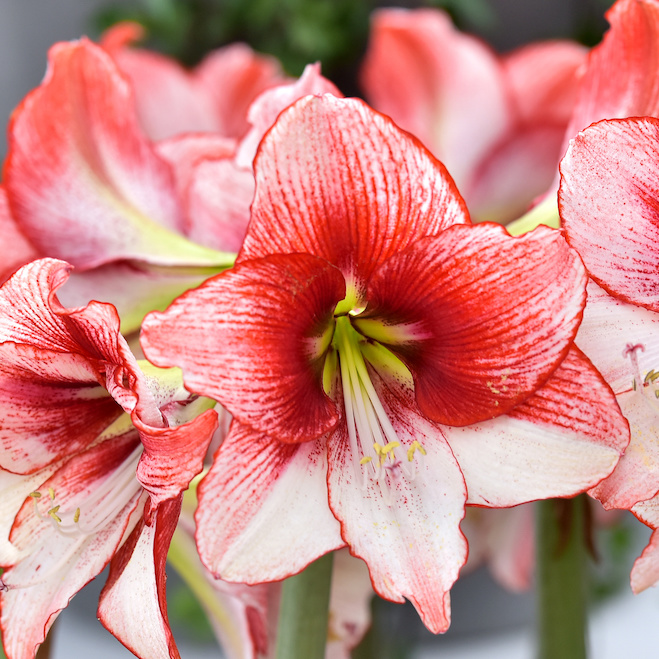
The winter holidays have several plants associated with them, one of which is the amaryllis bulb. Coming primarily in festive colors of red and white, with some pink and salmon for good measure, it makes for an impressive holiday plant when in full bloom. Although commonly known as amaryllis, its botanical name is hippeastrum, and true amaryllis are fall blooming, pink-flowered bulbs.
However, despite no longer being botanically a true amaryllis, it is aptly named, as the word “amaryllis” is derived from the Greek meaning “to sparkle”, and if you look at the petals in the right light you will see they have a sheen to them. There is also a legend attached to the flower which goes as follows:
Amaryllis was a nymph, who fell in love with a handsome shepherd, Alteo. Alteo was a single-minded man, interested only in flowers and gardening. Desperate to attract his attention, Amaryllis consulted the oracle at Delphi, and was told that for thirty days she should go to his cottage and pierce her heart with a golden arrow so that drops of blood would fall. On the thirtieth day beautiful red flowers sprang from the drops of blood, which not only impressed Alteo, given his love of flowers, but also caused him to fall in love with Amaryllis. This healed Amaryllis’s heart, and Alteo named the flowers after his new-found love.
Fortunately, these days no one has to go to such lengths to enjoy these beautiful flowers. Amateur enthusiasts in Europe began hybridizing amaryllis bulbs in the late 18th century, and by the mid-19th century, this interest had also spread to the US. Today there are more than 600 named cultivars, with today’s hybrids being developed primarily by breeders in Holland, South Africa, the United States, Japan and Israel. Considering it takes 15-20 years to develop and bring a new cultivar to market, it shows that there is plenty of dedication to this plant! Each holiday season the US imports over 10 million amaryllis bulbs, with these bulbs coming mainly from Holland and South Africa.
In their native environment of sub-tropical and tropical South America and the Caribbean, amaryllis are spring and summer flowering bulbs, which go dormant over winter. The bulbs we buy for the holidays have been specially prepared to force them into blooming out of season, but with care it is possible to have them re-bloom year after year.
Whether you want to have your bulbs bloom again for the holidays, or are happy to let them follow a more natural course, after-flowering care is similar. Once the flowers have finished, remove them. Let the leaves develop fully so the bulb can manufacture its food store for the next flowering season, and ensure that your plant is regularly watered and fertilized for 5-6 months. As soon as frosts have passed in the spring, put the bulb outside, initially in a shady spot and gradually acclimatize it to a sunny location.
If you wish to have your bulb bloom again for the holidays, you will need to start preparing it at least 14 weeks before you want it to flower. At that point in time, stop fertilizing and watering, allowing the foliage to yellow and start to die down. When this happens, cut the leaves back to 2” from the top of the bulb and remove it from the soil. Clean the bulb, and store it in a cool, dark place for a minimum of 6 weeks, after which your bulb is ready to re-plant. Alternatively, if you are happy to let it revert to a natural bloom schedule, you can wait until colder weather causes the leaves to die back, and you can store your potted plant in a cool, frost free place for whatever period of dormancy it chooses to take. Just ensure in this case that you do not allow the soil to completely dry out. Once you see new growth, bring the bulb to a bright and warmer location, water moderately and enjoy the flowers when they emerge.
And lastly, if all this seems too much like hard work, the growers have an amaryllis just for you! The newest trend is for wax-dipped bulbs. They have been prepared in such a way that the wax coating ensures the bulb contains all the moisture it needs in order to flower. As the bulb itself is its own food store, nothing more is needed to enjoy several weeks of beautiful flowers. Once they are done, they are not designed to be kept as in preparation the basal plate has been removed, and without that the bulb will not grow roots. Perfect for your friends who profess a “brown thumb”!
Regardless of how you grow them, amaryllis bulbs are an impressive sight, and deserve a place in everyone’s home.
Sources:







